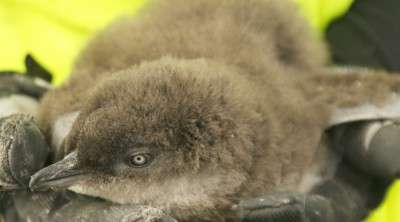A penguin's tale: Diet linked to breeding failure

(Phys.org) —A study on a Victorian penguin colony has revealed new insight into the link between seabird diet and breeding success.
In a study published in Functional Ecology, Nicole Kowalczyk and Associate Professor Richard Reina of Monash University's School of Biological Sciences, in collaboration with Andre Chiaradia from Phillip Island Nature Parks, studied Melbourne's St Kilda little penguin colony over two years.
They detailed how changes to prey abundance or food sources influenced reproductive success, tracking the penguins' nesting and feeding behaviour during the 2010 and 2011 breeding season.
Given previous data had shown that the colony fed mainly on anchovy which accounted for up to 78 per cent of their diet between years 2004 and 2008, the researchers predicted that changes in abundance would impact on the reproductive success of the colony - but they were surprised to find the little penguins were resilient to changing conditions only if alternative prey such as sardines could be found.
Ms Kowalczyk said breeding failure in seabirds has been associated with declines in prey abundance, and the quality and diversity of prey - but identifying which aspect of diet was responsible was challenging.
"The St Kilda little penguin colony has a short foraging range and displays narrow dietary diversity so this gave us the unique ability to identify how changes in food supply influence their reproduction," Ms Kowalczyk said.
"We found that a sharp decline of anchovy in 2010 had a negative impact on little penguin reproduction. However, in 2011, despite the relatively low anchovy abundance, their breeding success was extremely high.
"We believe the decrease of anchovy itself was not the only cause for low breeding success in 2010 but in combination with the scarcity of alternative prey. Our results show that little penguins are resilient to changes in their preferred prey but their ability to adapt to these changes is limited by the availability of alternative prey species."
Ms Kowalczyk said understanding seabird diet was integral to their conservation and management.
"Our results highlight that resource abundance and the availability of a variety of prey are critical factors in enabling this inshore seabird to adjust to changes in environmental conditions and fluctuations in their primary source of prey," Ms Kowalczyk said.
"Dietary changes have been linked to population declines and provide information about foraging conditions, particular prey species and foraging locations that require protection."
More information: Kowalczyk, N. D., Chiaradia, A., Preston, T. J., Reina, R. D. (2013), Linking dietary shifts and reproductive failure in seabirds: a stable isotope approach. Functional Ecology. DOI: 10.1111/1365-2435.12216
Journal information: Functional Ecology
Provided by Monash University
















